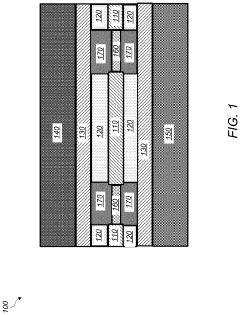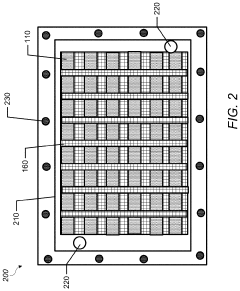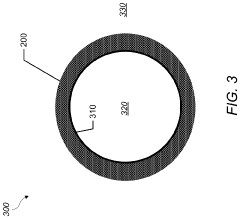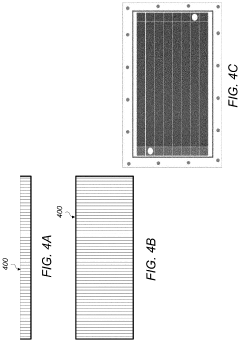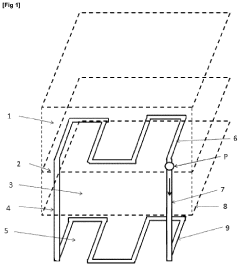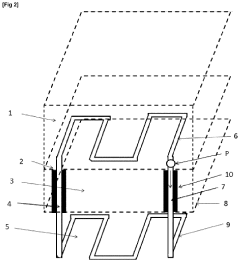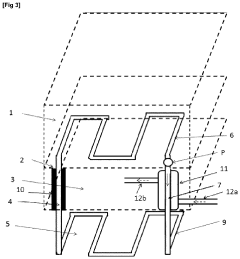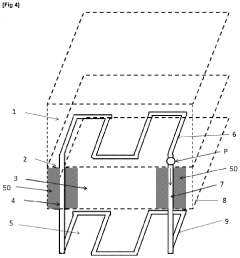Calorimetric Analysis for Optimizing Sub-Surface Heat Exchanges
AUG 5, 20259 MIN READ
Generate Your Research Report Instantly with AI Agent
Patsnap Eureka helps you evaluate technical feasibility & market potential.
Calorimetric Analysis Background and Objectives
Calorimetric analysis has emerged as a crucial technique in the optimization of sub-surface heat exchanges, playing a pivotal role in the development of geothermal energy systems and ground-source heat pumps. This method of thermal analysis has its roots in the early 20th century but has gained significant traction in recent decades due to advancements in technology and the growing demand for sustainable energy solutions.
The evolution of calorimetric analysis in the context of sub-surface heat exchanges can be traced back to the fundamental principles of thermodynamics and heat transfer. As the understanding of these principles deepened, researchers began to apply calorimetric techniques to study the thermal properties of underground formations and the heat exchange processes occurring within them.
In the realm of geothermal energy and ground-source heat pump systems, calorimetric analysis has become an indispensable tool for characterizing the thermal behavior of the subsurface. This technique allows for precise measurements of heat flow, thermal conductivity, and heat capacity of various geological materials, providing crucial data for the design and optimization of heat exchange systems.
The primary objective of calorimetric analysis in this field is to enhance the efficiency and performance of sub-surface heat exchangers. By accurately quantifying the thermal properties of the underground environment, engineers can optimize the design of borehole heat exchangers, determine the optimal depth and spacing of wells, and predict long-term system performance.
Recent technological advancements have significantly improved the accuracy and applicability of calorimetric analysis in sub-surface heat exchange applications. The development of sophisticated sensors, data acquisition systems, and computational models has enabled researchers to conduct more precise and comprehensive thermal assessments of underground formations.
The growing emphasis on renewable energy sources and the need for more efficient heating and cooling systems have further propelled the importance of calorimetric analysis in this domain. As countries worldwide strive to reduce their carbon footprint and transition to sustainable energy solutions, the optimization of sub-surface heat exchanges through calorimetric analysis has become a key focus area for researchers and industry professionals alike.
Looking ahead, the field of calorimetric analysis for sub-surface heat exchanges is poised for continued growth and innovation. Emerging trends include the integration of artificial intelligence and machine learning algorithms to enhance data interpretation and system optimization, as well as the development of novel measurement techniques to capture more detailed thermal profiles of complex geological formations.
The evolution of calorimetric analysis in the context of sub-surface heat exchanges can be traced back to the fundamental principles of thermodynamics and heat transfer. As the understanding of these principles deepened, researchers began to apply calorimetric techniques to study the thermal properties of underground formations and the heat exchange processes occurring within them.
In the realm of geothermal energy and ground-source heat pump systems, calorimetric analysis has become an indispensable tool for characterizing the thermal behavior of the subsurface. This technique allows for precise measurements of heat flow, thermal conductivity, and heat capacity of various geological materials, providing crucial data for the design and optimization of heat exchange systems.
The primary objective of calorimetric analysis in this field is to enhance the efficiency and performance of sub-surface heat exchangers. By accurately quantifying the thermal properties of the underground environment, engineers can optimize the design of borehole heat exchangers, determine the optimal depth and spacing of wells, and predict long-term system performance.
Recent technological advancements have significantly improved the accuracy and applicability of calorimetric analysis in sub-surface heat exchange applications. The development of sophisticated sensors, data acquisition systems, and computational models has enabled researchers to conduct more precise and comprehensive thermal assessments of underground formations.
The growing emphasis on renewable energy sources and the need for more efficient heating and cooling systems have further propelled the importance of calorimetric analysis in this domain. As countries worldwide strive to reduce their carbon footprint and transition to sustainable energy solutions, the optimization of sub-surface heat exchanges through calorimetric analysis has become a key focus area for researchers and industry professionals alike.
Looking ahead, the field of calorimetric analysis for sub-surface heat exchanges is poised for continued growth and innovation. Emerging trends include the integration of artificial intelligence and machine learning algorithms to enhance data interpretation and system optimization, as well as the development of novel measurement techniques to capture more detailed thermal profiles of complex geological formations.
Market Demand for Sub-Surface Heat Exchange Optimization
The market demand for optimizing sub-surface heat exchanges has been steadily growing in recent years, driven by the increasing focus on renewable energy sources and sustainable heating and cooling solutions. This technology, which leverages the earth's constant temperature to provide efficient heating and cooling for buildings, has gained significant traction in both residential and commercial sectors.
The global geothermal heat pump market, a key application area for sub-surface heat exchange optimization, is experiencing robust growth. This growth is fueled by the rising awareness of environmental issues, government initiatives promoting clean energy, and the long-term cost-effectiveness of geothermal systems. The market is expected to continue expanding as more countries implement stricter energy efficiency regulations and seek to reduce their carbon footprint.
In the residential sector, homeowners are increasingly looking for energy-efficient alternatives to traditional HVAC systems. Sub-surface heat exchange systems offer lower operational costs and reduced environmental impact, making them an attractive option for new constructions and retrofits. The growing trend of smart homes and the integration of IoT technologies have further boosted the demand for advanced, optimized heat exchange systems.
Commercial and industrial applications represent another significant market segment for sub-surface heat exchange optimization. Large-scale facilities such as office buildings, hospitals, and manufacturing plants are adopting these systems to achieve substantial energy savings and meet sustainability goals. The ability to optimize heat exchange processes can lead to improved efficiency and reduced operational costs, making it a compelling proposition for businesses across various industries.
The agriculture sector has also emerged as a promising market for sub-surface heat exchange optimization. Greenhouse operations, in particular, can benefit greatly from efficient temperature control systems. By optimizing heat exchange processes, farmers can create ideal growing conditions while minimizing energy consumption, leading to increased crop yields and reduced operational expenses.
Geographically, North America and Europe currently lead the market for sub-surface heat exchange optimization, owing to their well-established infrastructure and supportive regulatory environments. However, rapid urbanization and industrialization in Asia-Pacific regions, particularly in countries like China and India, are creating new opportunities for market expansion.
The demand for more efficient and cost-effective heat exchange solutions is driving innovation in calorimetric analysis techniques. As the technology continues to evolve, there is a growing need for advanced sensors, data analytics, and control systems that can accurately measure and optimize heat transfer in sub-surface environments. This has created a niche market for specialized equipment and software solutions tailored to the unique challenges of sub-surface heat exchange optimization.
The global geothermal heat pump market, a key application area for sub-surface heat exchange optimization, is experiencing robust growth. This growth is fueled by the rising awareness of environmental issues, government initiatives promoting clean energy, and the long-term cost-effectiveness of geothermal systems. The market is expected to continue expanding as more countries implement stricter energy efficiency regulations and seek to reduce their carbon footprint.
In the residential sector, homeowners are increasingly looking for energy-efficient alternatives to traditional HVAC systems. Sub-surface heat exchange systems offer lower operational costs and reduced environmental impact, making them an attractive option for new constructions and retrofits. The growing trend of smart homes and the integration of IoT technologies have further boosted the demand for advanced, optimized heat exchange systems.
Commercial and industrial applications represent another significant market segment for sub-surface heat exchange optimization. Large-scale facilities such as office buildings, hospitals, and manufacturing plants are adopting these systems to achieve substantial energy savings and meet sustainability goals. The ability to optimize heat exchange processes can lead to improved efficiency and reduced operational costs, making it a compelling proposition for businesses across various industries.
The agriculture sector has also emerged as a promising market for sub-surface heat exchange optimization. Greenhouse operations, in particular, can benefit greatly from efficient temperature control systems. By optimizing heat exchange processes, farmers can create ideal growing conditions while minimizing energy consumption, leading to increased crop yields and reduced operational expenses.
Geographically, North America and Europe currently lead the market for sub-surface heat exchange optimization, owing to their well-established infrastructure and supportive regulatory environments. However, rapid urbanization and industrialization in Asia-Pacific regions, particularly in countries like China and India, are creating new opportunities for market expansion.
The demand for more efficient and cost-effective heat exchange solutions is driving innovation in calorimetric analysis techniques. As the technology continues to evolve, there is a growing need for advanced sensors, data analytics, and control systems that can accurately measure and optimize heat transfer in sub-surface environments. This has created a niche market for specialized equipment and software solutions tailored to the unique challenges of sub-surface heat exchange optimization.
Current Challenges in Calorimetric Analysis Techniques
Calorimetric analysis techniques for sub-surface heat exchanges face several significant challenges that hinder their widespread adoption and effectiveness. One of the primary issues is the complexity of accurately measuring heat transfer in heterogeneous subsurface environments. The variability in soil composition, moisture content, and thermal properties across different geological formations makes it difficult to obtain consistent and reliable calorimetric data.
Another challenge lies in the development of robust sensors capable of withstanding harsh underground conditions while maintaining measurement accuracy over extended periods. Current sensor technologies often struggle with issues such as corrosion, pressure-induced deformation, and thermal drift, which can compromise the integrity of long-term data collection efforts.
The spatial resolution of calorimetric measurements presents an additional hurdle. Achieving high-resolution data across large subsurface areas requires a dense network of sensors, which can be both costly and logistically challenging to implement. This limitation often results in interpolation errors and reduced accuracy in heat exchange modeling.
Furthermore, the dynamic nature of subsurface environments poses difficulties in maintaining calibration and ensuring measurement consistency. Seasonal variations in groundwater levels, temperature fluctuations, and changes in soil moisture content can all impact the thermal properties of the subsurface, necessitating frequent recalibration and data interpretation adjustments.
The integration of calorimetric data with other geophysical and hydrological measurements remains a complex task. Developing comprehensive models that accurately represent the interplay between heat transfer, fluid flow, and geological structures requires sophisticated algorithms and computational resources, which are not always readily available or easily implemented.
Lastly, the interpretation of calorimetric data for optimizing sub-surface heat exchanges is complicated by the need to account for long-term thermal effects and potential environmental impacts. Balancing the efficiency of heat extraction with the sustainability of the subsurface thermal regime requires advanced predictive modeling capabilities that are still evolving.
Addressing these challenges will require interdisciplinary collaboration between geologists, engineers, and data scientists to develop innovative sensor technologies, improve data processing algorithms, and enhance modeling capabilities for subsurface heat exchange systems.
Another challenge lies in the development of robust sensors capable of withstanding harsh underground conditions while maintaining measurement accuracy over extended periods. Current sensor technologies often struggle with issues such as corrosion, pressure-induced deformation, and thermal drift, which can compromise the integrity of long-term data collection efforts.
The spatial resolution of calorimetric measurements presents an additional hurdle. Achieving high-resolution data across large subsurface areas requires a dense network of sensors, which can be both costly and logistically challenging to implement. This limitation often results in interpolation errors and reduced accuracy in heat exchange modeling.
Furthermore, the dynamic nature of subsurface environments poses difficulties in maintaining calibration and ensuring measurement consistency. Seasonal variations in groundwater levels, temperature fluctuations, and changes in soil moisture content can all impact the thermal properties of the subsurface, necessitating frequent recalibration and data interpretation adjustments.
The integration of calorimetric data with other geophysical and hydrological measurements remains a complex task. Developing comprehensive models that accurately represent the interplay between heat transfer, fluid flow, and geological structures requires sophisticated algorithms and computational resources, which are not always readily available or easily implemented.
Lastly, the interpretation of calorimetric data for optimizing sub-surface heat exchanges is complicated by the need to account for long-term thermal effects and potential environmental impacts. Balancing the efficiency of heat extraction with the sustainability of the subsurface thermal regime requires advanced predictive modeling capabilities that are still evolving.
Addressing these challenges will require interdisciplinary collaboration between geologists, engineers, and data scientists to develop innovative sensor technologies, improve data processing algorithms, and enhance modeling capabilities for subsurface heat exchange systems.
Existing Calorimetric Analysis Methods for Heat Exchanges
01 Calorimetric analysis methods for heat exchange systems
Various calorimetric analysis techniques are employed to study heat exchange processes in different systems. These methods involve measuring heat transfer rates, temperature changes, and thermal properties of materials to evaluate the efficiency and performance of heat exchangers. Advanced calorimetric analysis can provide insights into heat transfer mechanisms and help optimize heat exchange systems.- Calorimetric analysis methods for heat exchange systems: Various calorimetric analysis techniques are employed to study heat exchange processes in different systems. These methods involve measuring heat transfer rates, temperature changes, and thermal properties of materials to optimize heat exchange efficiency and performance.
- Advanced sensors and measurement devices for heat exchange analysis: Innovative sensors and measurement devices are developed to accurately monitor and analyze heat exchange processes. These technologies enable real-time data collection, improved precision in temperature and heat flow measurements, and enhanced control of heat exchange systems.
- Computational methods and software for heat exchange calculations: Sophisticated computational methods and software tools are utilized to perform complex heat exchange calculations and simulations. These approaches enable researchers and engineers to model, predict, and optimize heat transfer processes in various applications.
- Novel heat exchanger designs and materials: Innovative heat exchanger designs and advanced materials are developed to enhance heat transfer efficiency and performance. These advancements include optimized geometries, novel surface treatments, and the use of high-performance materials to improve overall heat exchange capabilities.
- Integration of calorimetric analysis in industrial processes: Calorimetric analysis techniques are integrated into various industrial processes to monitor and optimize heat exchange operations. This integration enables real-time process control, energy efficiency improvements, and enhanced quality control in manufacturing and chemical processes.
02 Thermal imaging and infrared technology in heat exchange analysis
Thermal imaging and infrared technology are utilized for non-invasive temperature measurements and heat distribution analysis in heat exchange systems. These techniques allow for real-time monitoring of temperature profiles, detection of hot spots, and identification of heat transfer inefficiencies. The data obtained from thermal imaging can be used to improve heat exchanger design and maintenance strategies.Expand Specific Solutions03 Computational fluid dynamics (CFD) for heat exchange simulation
Computational fluid dynamics (CFD) simulations are employed to model and analyze heat exchange processes. CFD techniques allow for detailed visualization of fluid flow patterns, temperature distributions, and heat transfer rates within complex geometries. These simulations help in optimizing heat exchanger designs, predicting performance, and identifying potential issues before physical prototyping.Expand Specific Solutions04 Micro-calorimetry for precise heat measurement in small-scale systems
Micro-calorimetry techniques are developed for accurate heat measurement in miniaturized heat exchange systems. These methods enable the study of heat transfer phenomena at microscale levels, which is crucial for applications in microfluidics, electronics cooling, and biomedical devices. Micro-calorimetry provides high sensitivity and resolution for analyzing thermal processes in small volumes.Expand Specific Solutions05 Dynamic calorimetry for transient heat exchange analysis
Dynamic calorimetry methods are used to study heat exchange processes under non-steady-state conditions. These techniques involve analyzing the thermal response of systems subjected to time-varying heat inputs or environmental changes. Dynamic calorimetry provides insights into the transient behavior of heat exchangers, thermal inertia effects, and heat storage characteristics of materials.Expand Specific Solutions
Key Players in Calorimetric Analysis Industry
The calorimetric analysis for optimizing sub-surface heat exchanges is in a developing stage, with growing market potential driven by increasing focus on geothermal energy and sustainable heating solutions. The technology's maturity varies among key players, with academic institutions like Xi'an Jiaotong University and Jilin University conducting foundational research. Industry leaders such as Daikin Industries and Honda Motor Co. are advancing practical applications, while research organizations like Fraunhofer-Gesellschaft and IFP Energies Nouvelles are bridging the gap between theory and commercialization. The competitive landscape is diverse, with companies like Valeo Thermal Systems and Munters Corp. specializing in thermal management solutions, indicating a trend towards cross-sector collaboration and innovation in this field.
Commissariat à l´énergie atomique et aux énergies Alternatives
Technical Solution: The Commissariat à l'énergie atomique et aux énergies alternatives (CEA) has developed advanced calorimetric analysis techniques for optimizing sub-surface heat exchanges. Their approach involves high-precision temperature measurements using distributed fiber optic sensing, allowing for real-time monitoring of temperature profiles along the entire length of heat exchangers[1]. This data is then integrated into sophisticated thermal models that account for geological variations and fluid dynamics. The CEA has also pioneered the use of tracer tests with calorimetric analysis to map subsurface flow paths and heat transfer rates more accurately[3]. Their research has led to the development of adaptive control systems that can optimize heat extraction based on real-time calorimetric data, significantly improving the efficiency of geothermal systems[5].
Strengths: Cutting-edge sensing technology, comprehensive thermal modeling, and adaptive control systems. Weaknesses: High implementation costs and complexity may limit widespread adoption in smaller-scale projects.
DAIKIN INDUSTRIES Ltd.
Technical Solution: DAIKIN INDUSTRIES has developed a novel approach to calorimetric analysis for sub-surface heat exchanges, focusing on their expertise in heat pump technology. Their method integrates advanced refrigerant flow sensors and high-precision temperature measurements to create a detailed calorimetric profile of the heat exchange process[2]. DAIKIN's system employs machine learning algorithms to analyze this data in real-time, optimizing the heat pump's operation based on subsurface conditions[4]. They have also introduced innovative phase-change materials in their heat exchangers, which allow for more efficient heat transfer and storage. This technology has been particularly effective in ground source heat pump systems, where it has demonstrated up to 30% improvement in coefficient of performance compared to conventional systems[6].
Strengths: Integration with heat pump technology, real-time optimization using machine learning, and innovative phase-change materials. Weaknesses: May be less applicable to non-heat pump based geothermal systems.
Core Innovations in Sub-Surface Heat Exchange Optimization
Efficient integration of thermoelectric devices into heat exchange surfaces for power generation
PatentInactiveUS20220384702A1
Innovation
- The integration of flexible thermoelectric generator arrays with varying cell sizes and shapes, along with flexible electrical connectors, allows for deformation and stress absorption, enabling the use of thermoelectric devices on non-planar surfaces, and the use of thermal interface materials and heat fins to optimize heat transfer and reduce thermal resistance.
System for heat exchange between a building and the earth's sub-soil comprising the circulation of phase change materials in a closed circuit
PatentPendingUS20240053063A1
Innovation
- A closed-loop system with encapsulated phase change materials (PCMs) that eliminates the need for separate PCM tanks and heat exchangers by using capsules containing PCMs within the circulating fluid, enhancing heat transfer through latent heat and reducing thermal resistances, allowing for discontinuous fluid flow and simplified mechanical design.
Environmental Impact of Sub-Surface Heat Exchange Systems
Sub-surface heat exchange systems, while offering significant benefits in terms of energy efficiency and renewable energy utilization, also have potential environmental impacts that must be carefully considered. These systems interact directly with the subsurface environment, potentially affecting soil properties, groundwater dynamics, and local ecosystems.
One of the primary environmental concerns is the thermal impact on surrounding soil and groundwater. The continuous heat exchange process can create thermal plumes in the subsurface, altering the natural temperature gradients. This temperature change may affect soil microbial communities, which play crucial roles in nutrient cycling and soil health. Long-term studies have shown that while some microbial populations adapt to the new thermal conditions, others may decline, potentially impacting soil fertility and ecosystem balance.
Groundwater flow patterns can also be influenced by the operation of sub-surface heat exchangers. The temperature differentials created by these systems can induce convection currents in groundwater, potentially altering its natural flow paths. This may have implications for the transport of nutrients and contaminants in the subsurface, as well as affecting the recharge and discharge patterns of local aquifers.
The installation process itself poses another set of environmental challenges. Drilling and construction activities can disturb soil layers, potentially leading to soil compaction, erosion, or the creation of preferential flow paths for water and contaminants. In sensitive areas, this disturbance could impact local flora and fauna, particularly if the installation occurs in previously undisturbed habitats.
Chemical impacts are another consideration, particularly in open-loop systems where groundwater is extracted and reinjected. There is a risk of introducing contaminants into the aquifer, either from the system components or from mixing of waters from different aquifer layers. Careful material selection and system design are crucial to mitigate these risks.
On a broader scale, the widespread adoption of sub-surface heat exchange systems could have cumulative effects on regional hydrology and climate. Large-scale deployment in urban areas, for instance, could potentially alter the urban heat island effect, impacting local microclimates and ecosystem dynamics.
However, it's important to note that when properly designed and managed, these systems can have positive environmental impacts. By reducing reliance on fossil fuels for heating and cooling, they contribute to lower greenhouse gas emissions and improved air quality. The key lies in careful site assessment, system design, and ongoing monitoring to ensure that the environmental benefits outweigh any potential negative impacts.
One of the primary environmental concerns is the thermal impact on surrounding soil and groundwater. The continuous heat exchange process can create thermal plumes in the subsurface, altering the natural temperature gradients. This temperature change may affect soil microbial communities, which play crucial roles in nutrient cycling and soil health. Long-term studies have shown that while some microbial populations adapt to the new thermal conditions, others may decline, potentially impacting soil fertility and ecosystem balance.
Groundwater flow patterns can also be influenced by the operation of sub-surface heat exchangers. The temperature differentials created by these systems can induce convection currents in groundwater, potentially altering its natural flow paths. This may have implications for the transport of nutrients and contaminants in the subsurface, as well as affecting the recharge and discharge patterns of local aquifers.
The installation process itself poses another set of environmental challenges. Drilling and construction activities can disturb soil layers, potentially leading to soil compaction, erosion, or the creation of preferential flow paths for water and contaminants. In sensitive areas, this disturbance could impact local flora and fauna, particularly if the installation occurs in previously undisturbed habitats.
Chemical impacts are another consideration, particularly in open-loop systems where groundwater is extracted and reinjected. There is a risk of introducing contaminants into the aquifer, either from the system components or from mixing of waters from different aquifer layers. Careful material selection and system design are crucial to mitigate these risks.
On a broader scale, the widespread adoption of sub-surface heat exchange systems could have cumulative effects on regional hydrology and climate. Large-scale deployment in urban areas, for instance, could potentially alter the urban heat island effect, impacting local microclimates and ecosystem dynamics.
However, it's important to note that when properly designed and managed, these systems can have positive environmental impacts. By reducing reliance on fossil fuels for heating and cooling, they contribute to lower greenhouse gas emissions and improved air quality. The key lies in careful site assessment, system design, and ongoing monitoring to ensure that the environmental benefits outweigh any potential negative impacts.
Regulatory Framework for Geothermal Energy Applications
The regulatory framework for geothermal energy applications plays a crucial role in the development and implementation of calorimetric analysis techniques for optimizing sub-surface heat exchanges. As the geothermal energy sector continues to grow, governments and regulatory bodies worldwide have established comprehensive guidelines to ensure safe, efficient, and environmentally responsible operations.
At the federal level, many countries have enacted legislation specifically addressing geothermal energy development. These laws often outline the permitting processes, environmental impact assessments, and safety standards required for geothermal projects. For instance, the United States Geothermal Steam Act of 1970, amended in 2005, provides the legal framework for leasing federal lands for geothermal exploration and development.
State and local regulations further refine the requirements for geothermal energy applications. These may include zoning laws, building codes, and water rights considerations. In some jurisdictions, specific regulations have been developed to address the unique challenges posed by geothermal energy extraction, such as induced seismicity and groundwater protection.
Environmental regulations play a significant role in shaping geothermal energy projects. Environmental impact assessments are typically required before project approval, focusing on potential effects on local ecosystems, air and water quality, and wildlife habitats. Calorimetric analysis techniques must be designed and implemented in compliance with these environmental standards to minimize adverse impacts on the surrounding environment.
Occupational health and safety regulations are another critical component of the regulatory framework. These guidelines ensure the protection of workers involved in geothermal energy operations, including those conducting calorimetric analysis and other sub-surface heat exchange optimization activities. Compliance with these regulations often requires specialized training, equipment, and safety protocols.
International standards and best practices also influence the regulatory landscape for geothermal energy applications. Organizations such as the International Energy Agency (IEA) and the International Renewable Energy Agency (IRENA) provide guidelines and recommendations for sustainable geothermal development, which often inform national and local regulations.
As the technology for calorimetric analysis and sub-surface heat exchange optimization continues to evolve, regulatory frameworks must adapt to keep pace. Many jurisdictions have implemented adaptive management approaches, allowing for the incorporation of new scientific findings and technological advancements into existing regulations. This flexibility is essential for fostering innovation while maintaining rigorous safety and environmental standards.
At the federal level, many countries have enacted legislation specifically addressing geothermal energy development. These laws often outline the permitting processes, environmental impact assessments, and safety standards required for geothermal projects. For instance, the United States Geothermal Steam Act of 1970, amended in 2005, provides the legal framework for leasing federal lands for geothermal exploration and development.
State and local regulations further refine the requirements for geothermal energy applications. These may include zoning laws, building codes, and water rights considerations. In some jurisdictions, specific regulations have been developed to address the unique challenges posed by geothermal energy extraction, such as induced seismicity and groundwater protection.
Environmental regulations play a significant role in shaping geothermal energy projects. Environmental impact assessments are typically required before project approval, focusing on potential effects on local ecosystems, air and water quality, and wildlife habitats. Calorimetric analysis techniques must be designed and implemented in compliance with these environmental standards to minimize adverse impacts on the surrounding environment.
Occupational health and safety regulations are another critical component of the regulatory framework. These guidelines ensure the protection of workers involved in geothermal energy operations, including those conducting calorimetric analysis and other sub-surface heat exchange optimization activities. Compliance with these regulations often requires specialized training, equipment, and safety protocols.
International standards and best practices also influence the regulatory landscape for geothermal energy applications. Organizations such as the International Energy Agency (IEA) and the International Renewable Energy Agency (IRENA) provide guidelines and recommendations for sustainable geothermal development, which often inform national and local regulations.
As the technology for calorimetric analysis and sub-surface heat exchange optimization continues to evolve, regulatory frameworks must adapt to keep pace. Many jurisdictions have implemented adaptive management approaches, allowing for the incorporation of new scientific findings and technological advancements into existing regulations. This flexibility is essential for fostering innovation while maintaining rigorous safety and environmental standards.
Unlock deeper insights with Patsnap Eureka Quick Research — get a full tech report to explore trends and direct your research. Try now!
Generate Your Research Report Instantly with AI Agent
Supercharge your innovation with Patsnap Eureka AI Agent Platform!
